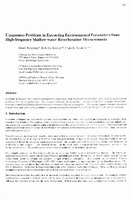| dc.contributor.author | Weinberg, Henry | |
| dc.contributor.author | Keenan, Ruth Eta | |
| dc.contributor.author | Aidala, Frank E. | |
| dc.date.accessioned | 2018-10-11T14:08:32Z | |
| dc.date.available | 2018-10-11T14:08:32Z | |
| dc.date.issued | 1997 | |
| dc.identifier | 11521 | |
| dc.identifier.govdoc | CP-45 | |
| dc.identifier.uri | http://hdl.handle.net/20.500.12489/476 | |
| dc.description.abstract | Inversion techniques that extract environmental parameters from measured reverberation often lead to mathematical problems that are not well-posed. Two examples illustrate this possibility. The first hows how a model can produce accurate fonvard predictions though based on erroneous physical assumptions. The second example involves measured torpedo data, and offers some guidance to resolving ambiguities that are due to abrupt changes in the bottom sediment. | |
| dc.format | 6 p. : ill. ; digital, PDF file | |
| dc.language | English | |
| dc.publisher | NATO. SACLANTCEN | |
| dc.source | In: High Frequency Seafloor Acoustics (SACLANTCEN Conference Proceedings CP-45), 1997, pp. 587-592 | |
| dc.subject | Acoustic reverberation | |
| dc.subject | Shallow water | |
| dc.subject | Seafloor sediments | |
| dc.subject | High Frequency Acoustics | |
| dc.subject | Torpedoes | |
| dc.subject | Inverse problems | |
| dc.subject | Inverse scattering | |
| dc.title | Uniqueness problems in extracting environmental parameters from high-frequency shallow-water reverberation measurements | |
| dc.type | Papers and Articles | |
| dc.type | Conference Proceedings (CP) | |
